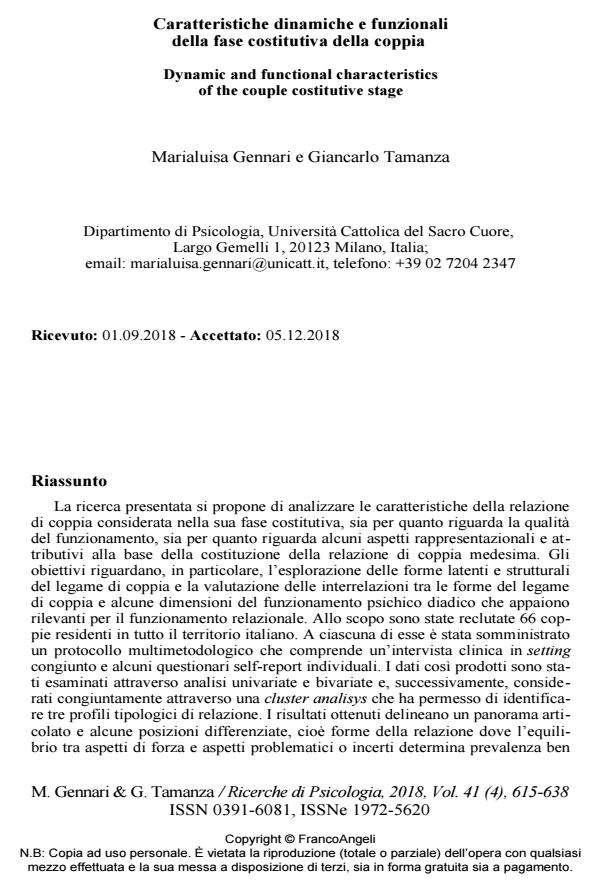Dynamic and functional characteristics of the couple costitutive stage
Journal title RICERCHE DI PSICOLOGIA
Author/s Marialuisa Gennari, Giancarlo Tamanza
Publishing Year 2019 Issue 2018/4
Language Italian Pages 24 P. 615-638 File size 232 KB
DOI 10.3280/RIP2018-004005
DOI is like a bar code for intellectual property: to have more infomation
click here
Below, you can see the article first page
If you want to buy this article in PDF format, you can do it, following the instructions to buy download credits

FrancoAngeli is member of Publishers International Linking Association, Inc (PILA), a not-for-profit association which run the CrossRef service enabling links to and from online scholarly content.
The research presented aims to analyze the characteristics of the couple rela-tionship considered in its constitutive phase, both as regards the quality of her functioning, and as regards some representational and attributive aspects at the base of the establishment of the couple relationship itself. The objectives con-cern, in particular, the exploration of the latent and structural forms of the couple bond and the evaluation of the interrelations between the forms of the couple bond and some dimensions of dyadic psychic functioning that appear relevant for relational functioning. For this purpose, 66 couples residing throughout Italy have been recruited. Each of them was given a multimethodological protocol which includes a joint clinical interview and some individual self-report question-naires. The data thus produced were examined through univariate and bivariate analyzes and, subsequently, considered jointly through a cluster analysis that al-lowed to identify three types of relationship profiles. The results obtained outline an articulated panorama and some differentiated positions, that is, forms of the relationship where the balance between aspects of force and problematic or un-certain aspects determines distinct prevalence. Three different clusters have been identified, distinguished by the relevance of properly relational variables with re-spect to personal variables. This would confirm the theoretical assumption pro-moted by the relational and systemic perspectives that consider the proprium of the couple relationship, independently of the construct considered, a surplus and a substantial specific otherness with respect to the personal contributions of the partners.
Keywords: Couple bond, couple constitution, couple identity, multimethod approach.
- The Clinical Generational Interview. An instrument for family assessment Giancarlo Tamanza, Marialuisa Gennari, in Frontiers in Psychology 1361028/2024
DOI: 10.3389/fpsyg.2024.1361028
Marialuisa Gennari, Giancarlo Tamanza, Caratteristiche dinamiche e funzionali della fase costitutiva della coppia in "RICERCHE DI PSICOLOGIA " 4/2018, pp 615-638, DOI: 10.3280/RIP2018-004005